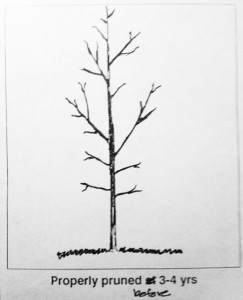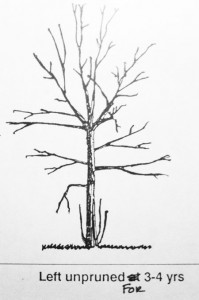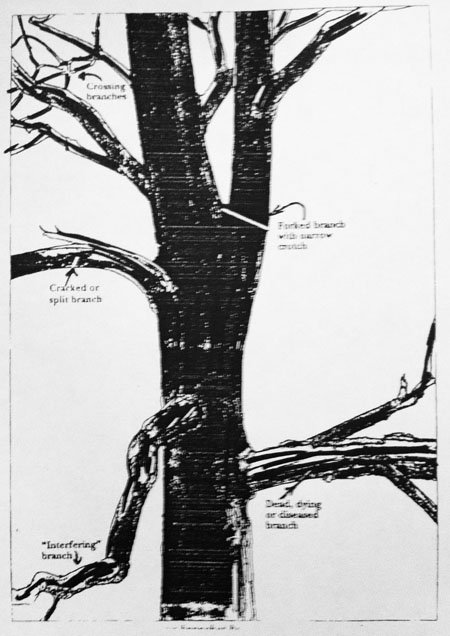Pruning young trees
The ideal time to prune trees is when they are young. Young ones recover more quickly from the cutting injury, and grow faster. When you remove extra branches, those that rub or are too low, you are encouraging the energy that would have gone into their growth, to go instead, into the growth of the rest of the tree. Further, you avoid having to do major surgery later on larger branches when the tree is less able to withstand it and the corrective cuts may be harder for the tree to recover from. These cuts will be more obvious and expensive because you will need a professional arborist. So, invest the time into your new trees and save time, effort and money in the future.

 Unless there is breakage from transport or weather, or the occasional rubbing branch, there is no need to prune young trees until they have been established in your yard for a year or more. If the tree is shaping up nicely, then do not do anything. If one of the following occurs, you may want to take care of it in the winter when the tree is dormant:
Unless there is breakage from transport or weather, or the occasional rubbing branch, there is no need to prune young trees until they have been established in your yard for a year or more. If the tree is shaping up nicely, then do not do anything. If one of the following occurs, you may want to take care of it in the winter when the tree is dormant:
- Remove all “water sprouts” (vertical shoots growing upward from horizontal limbs) and any sprouts emerging from the roots at the base of the tree. Some tree species have a tendency to produce sprouts more readily than others.
- Remove any branches with narrow crotches–that grow at sharp angles from the trunk. They will be more vulnerable to breakage from storms as the years go by. Check to see that the tree branches are growing at roughly at a 45 degree angle from the main trunk.
- Trim any branches that are crossing and are in danger of rubbing each other in the future. This improves the branching symmetry and beauty and avoids potential damage.
- Remove all branches that are growing inward toward the trunk or are growing at right angles, or sideways, from the branch at its tip.
- If two limbs are growing from the trunk very near each other–closer than 6 inches or so–remove one of them to establish evenly spaced lateral branches that can access good light and moisture.
- Remove smaller branches that are growing downward from a major limb to improve the branching pattern.
- Remove branches that are already too low or are already growing directly toward a building or wall. As the tree grows, they will remain at the same height and grow in the same direction and will interfere with mowing, mulching, and planting beneath the tree.
- Never use tree paint, wrapping or other material to seal or cover over a pruning wound. Research has shown that sealing the wound encourages more damage by sealing in infectious agents or insects that will damage the interior of the tree and block oxygen from the wound. Trees are capable of healing themselves if the pruning cuts are smooth, clean and along the branch bark collar. In fact, access to the air promotes healing.
Pruning mature trees
Tree species vary in their tendency to develop sprouts, weak crotches, and other vulnerabilities as they age. Mature trees that have not been pruned over the years to manage their growth and to protect their health, often need serious attention. They may have developed lots of interior branches that block air and light from reaching their major branches, trunk and foliage. They may have branches damaged from weather, a double trunk, crossing branches and other problems that pruning can correct. Some may have unwelcome invasive vines crawling all over them. Some may have branches that are showing signs of disease or are growing too close to nearby buildings.
When to call in professional arborists
 Depending on the size of your tree, you may be able to correct some of these problems yourself. If you find that you must climb a ladder to reach water sprouts that are too high for a pole pruner, or that offending branches are too big for a pruning saw, it is time to call in professional help.
Depending on the size of your tree, you may be able to correct some of these problems yourself. If you find that you must climb a ladder to reach water sprouts that are too high for a pole pruner, or that offending branches are too big for a pruning saw, it is time to call in professional help.
Call in a certified professional arborist when:
- the tree is so large that climbing or the use of a cherry picker bucket truck and a chainsaw is necessary to correct the problem.
- the tree is located near utility lines, other trees, buildings or highways.
- a tree is near a property line and corrective pruning may affect the neighbors.
- a tree develops fungus on its trunk or roots or when there are signs of serious pest infestation that requires removal of selected branches.
- major storm damage requires professional judgment on whether or how to save a tree.

